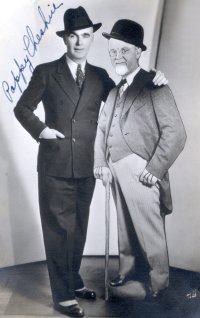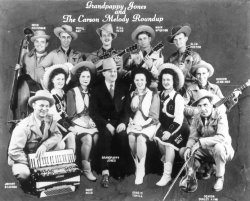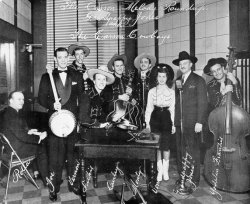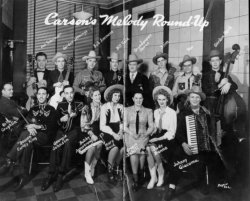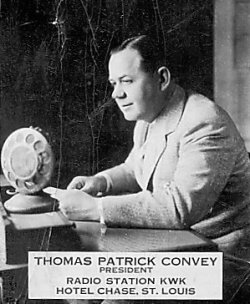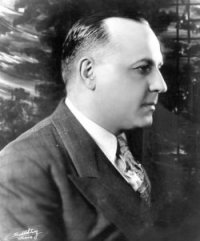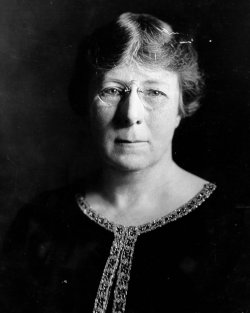Radio Articles
The Story Of Gabriel
by Robert W. Delaney
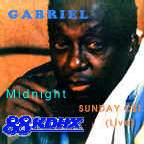
Monday 6 AM
It is about 6 AM on a Monday morning. I’m in the bedroom of my home, which is located just west of the neighborhood referred to in St. Louis, Missouri as “Dogtown”. I am listening to a small radio. The Disk Jockey is signing off of his program. “…And now, bye you bye, gotta go, gotta move, gotta split the scene, see ya next week… if the good lord is willing and the creeks don’t rise…” he says. He then plays a familiar theme song sung by Roy Rogers:
Happy trails to you…until we meet again Happy trails to you…keep smiling until then Who cares about the clouds when we’re together Just sing a song and bring the sunny weather Happy trails to you until we meet again.
Then the DJ says: “Happy trails to you…until we meet again. But I don’t know…It could be the last time”. He then plays an electrifying James Brown song:
Maybe the last time (singers answer with do-wop style phrase “Maybe…the last time”) It may be the last time (singers answer with do-wop style phrase “Maybe…the last time”) Maybe the last time Oh I…Oh I…. I don’t know … … … It may be the last time we shake hands It may be the last time we make plans Oh I…Oh I….I don’t know.
After the song fades out there is the sound of a door slamming and a grandmotherly female voice says “Gabriel! Stop making that noise!”. This signals the end of DJ Gabriel’s Tin Pan Alley weekly radio program heard from Midnight Sunday until 6 AM Monday mornings on community radio station KDHX-FM, 88.1 in St. Louis, Missouri.
There is a momentary feeling of emptiness and longing for more repartee and music. It is really an empty, puzzling emotion. It brings to mind a visit with a good friend or close relative and the feeling you get when the person leaves. It was such a good time you have just had listening to DJ Gabriel that you don’t want it to end so soon. In a few hours, you may be back at work dealing with the mundane things of life in the everyday business world. Listening to Gabriel exposes you to a deeper understanding of the little things in life that we overlook or ignore.
Who’s Listening? I suspect this scene and sudden emotion is repeated in many places and many minds where people listen to Gabriel. I’m sure a large group of the population with a musical taste for Blues and Traditional Gospel music have heard his broadcasts at one time or another during his 47-year career in radio broadcasting in the St. Louis, Missouri area and other parts of North America. His listeners are a diverse group including:
Old Friends in his home town of East St. Louis, Illinois and the North Side of Saint Louis, Missouri Those whose love for Traditional Black Gospel Music is filled by his one hour devoted to this music Those who desire to obtain an “Education in the Blues” Those who enjoy his unique observations and opinions Those who want to reminisce about the glory days of Rhythm And Blues (R & B) in the 1950’s and 1960’s Those who have a message they want him to pass on to his listeners Those who once were, still are, or want to make a living in Blues Music playing, promoting, writing about it, etc. Those who come across his program by chance on the local cable TV channel Those who enjoy hearing particularly rare records from the large collection he has Those who have come in contact with him through the Internet (e-mail and KDHX broadcasts on the Web) His appeal is diverse in the community, perhaps wider than any other media personality currently on St. Louis radio. In the era of strict playlist conformity, Gabriel and KDHX are a blessed oasis in the desert of ‘20 songs in a row’ and ‘Classic Rock’ stations.
Profile Of The Man In addition to his role as a disk jockey, Gabriel has also pursued the following activities at various time in his life:
Record Engineering, Production, And Distribution Of His Own And Other Artists Records on His Own Record Label And other Record Labels Bandleader, Trumpet Player, Pedal Steel Guitarist Proprietor Of A Retail Record Store Concert Promoter Television And Electronic Equipment Repairman Computer User And Internet Surfer
Each Monday I have to get up at 6:30 AM to go to work. Every Monday after 6 AM Gabriel heads home to East St. Louis, Illinois carrying 2 large suitcases filled with cassettes, CD’s, and records. His on-the-air assistant, a long-time listener to his programs, Dennis Branneker, helps him load up his car.
The 3 B’s So…How did I ever stumble across Gabriel and his program? In the summer of 1971 commercial radio station (sic) KDNA-FM, 102.5, was in its 3rd or 4th year on the air in St. Louis. It was classified as a listener-supported station. It existed on the donations of its listeners and the initial capital provided by investors. Its on-the-air staff was diverse and ever-changing. It included well-known local personalities like Leonard Slatkin, then a St. Louis Symphony conductor. It might include whomever walked in off the street to start broadcasting their agenda, if the mood was right. There were only a few scheduled programs at scheduled times, although certain DJ’s were usually on the same days. There was a lot of listener-DJ phone conversation which was not yet as popular of a radio format as it is today in the format called “talk-radio”. All types of music were played. There were no limits on what could be played. This type of format was pioneered by a San Francisco station, KSAN-FM. Most of the people working at KDNA were under the age of 30 at that time.
In the summer of 1971 I was listening to KDNA one Saturday morning about 3 AM through headphones I heard the following:
“And Now! For Your Dancing, Listening, and Reminiscing Pleasure! Ladies And Gentlemen! Here Is The Man! I Mean The Man! The Sensational! The Incomparable! The King Of The Blues! The Dynamic!” Then a friendly voice announced he was “Gabriel…playing the 3 B’s for you.” The voice continued “I do not mean Bach, Brahms, and Beethoven…… but Boogie, Barrelhouse, and Blues!”. As he spoke, a piano boogie tune started to play and continued while he talked over it. Gabriel’s Program Theme” (1:37).
The first record I heard him play was a blues tune with nice guitar work and harmonica, but the singer had such as weird way of singing the syllables: You’re the one Who rayeeeellly gave me a buzzzzz.
Years later, Gabriel would identify the song for me as ‘You’re The One’ by Jimmie Rogers, who was Muddy Waters’ Lead Guitar Player. Gabriel played mostly blues tunes that night until about 5 AM. This was the music that influenced the top rock musicians of the 1960’s. Groups such as the Beatles, the Jimi Hendrix Experience, Cream, Canned Heat, The Animals, The Rolling Stones, John Mayall, and numerous others all pointed to the blues as the major influence in their music.
The Rising Popularity Of The Blues The blues Gabriel was playing was an encyclopedia of new tunes to me. Hearing this music for the first time was very intriguing. I had vaguely heard the name Gabriel mentioned as a DJ on a St. Louis radio station, KATZ, but I had never really listened to that station much. Gabriel was also running a retail record store at the time, The House Of The Blues, not too far from the location of KDNA.
I liked black music, what you would call “Soul Music”, because this was what we grew up hearing in the 1960’s on AM radio stations along with the Beatles and other pop music. But I very seldom bought a record by a black artist. I was pretty much ignorant of the blues. This is one of the great factors in the blues appeal to whites. The songs are almost entirely new to whites.
The most specific experience with the blues that I had ever had was in 1971 when I occasionally listened to black church services (Protestant denominations) on Sunday evenings on radio station KATZ-AM 1600. The services would always feature beautiful group singing of songs I usually wasn’t familiar with. Then a preacher or a deacon would give a sermon. All during the sermon, those in the church would often answer the preacher after each sentence with phrases like “That’s Right!”
Amen!…Praise The Lord!….”. A member of the congregation might “testify” to his faith in Jesus or “witness” to his acceptance of Jesus as his savior. It was stirring, metaphysical stuff to listen to this service. Little did I realize that the blues was the basis of most black gospel music. Gabriel refers to it as the “Holy Blues”, which is now an accepted term for it. Most black blues performers had grown up going to church or singing in church at one time or another. I didn’t really listen to the service with sincerity, more with curiosity. I had heard John Lennon of the Beatles say that he liked gospel music and I had seen a film of the “Around The Beatles” TV special the Beatles made in England in 1964 which included their rare performance of “Shout”, an Isley Brothers tune with strong gospel influences.
So here we are in the year 2000 and the blues is at an all-time high in popularity and record sales, concert revenues, etc. Why is this so? The blues is a music that has been passed from generation to generation in the black community and this still continues in the Delta in Mississippi and other locations in the USA today. It is my opinion that the recent popularity of the blues has occurred because it is now the “New Rock And Roll” of white listeners who grew up in the 1960’s and 1970’s absorbing the music of their rock idols that was firmly based in the blues traditions of earlier decades. The persons in this age group (35 – 54) are now a powerful economic demographic group. In their youth, the blues was admired by rock musicians for its simplicity and authenticity. The blues has always been a music that tells the story of a person’s fate, good or bad. “The blues is the story of a good man with a problem” is an often-heard phrase.
The black person performing the blues usually represented a person alienated from the establishment for its poor treatment of blacks and racist attitude. In the 1960’s and 1970’s many young whites felt this same alienation and vowed to eliminate racism or reduce its effect. Some people feel that black music is ultimately what won over large groups of whites when segregation was an issue. This is a complex question that can’t be answered with snap answers and unsupported theories. The average middle-class white person in this age group feels alienated today in this era of job lay-offs, downsizings, temporary jobs, and the lack of loyalty between the employer and the employees. These white people are feeling some of the misery and pressure that always existed in the black person’s world due to racism.
Another interesting phenomenon is the popularity of blues festivals. Many of the old anti-establishment 1960’s and 1970’s young people are now the members and officers of the blues societies that organize and sponsor these festivals. The merchandising of the blues is just beginning. You can buy and wear your House Of Blues t-shirt or your Buddy Guy’s Legends club t-shirt (I have one) or your B. B. King pin. You can go on a “Blues Cruise” with well-known blues performers. There is something absurd about singing the blues on a cruise ship!
Blues performers today include many more whites. Many great established black performers continue to perform and some excellent new black performers are becoming successful also. But the establishment of the blues world if there is one is white, middle-aged, and middle class. I am not criticizing this fact, I’m just wondering why it has evolved this way. It is certainly ironic that this beautiful, vibrant, timeless music that was such a unique gift from God is now manipulated, sold, and controlled by white, suburban businessmen. In reading the history of blues recording in the 1920’s and 1930’s we find that the white power brokers have always controlled some aspect of blues music. In the history of black music in this century there have been several successful black recording entrepreneurs who profited in genres such as Blues, Soul, and Jazz, most notably the owners of the VeeJay and Motown labels.
Most white blues enthusiasts, myself included, have a genuine interest in the music’s history and wish to keep it alive and developing. Gabriel often bemoans the fact that most younger black people don’t show much interest or liking for the blues. Even the young black gospel groups of recent years do not rely much on the blues, another fact that Gabriel often mentions. Gabriel is quick to acknowledge that without the heavy support and interest of white blues enthusiasts, the music would be dead commercially.
St. Louis Blues Radio Another radio program, Baby Face Leroy’s Blues Hour, which ran on community station KWMU-FM 90.7 in the 1980’s was also an important factor in keeping the blues alive in St. Louis. This program was hosted by Leroy Pierson, an internationally-known blues guitarist and teacher, who has played with many of the top blues musicians of the last 50 years. This program was part of the beginning of a “blues education” for many of Gabriel’s current listeners.
At Radio station KDHX-FM, the management and other blues DJ’s besides Gabriel come from a wide background. Some of them are currently blues performers, some are just DJ’s as a hobby. Blues music is important enough to KDHX-FM that each daily blues show runs in drive-time Monday through Friday from 4 PM to 7 PM. On Sunday evening blues programming is on from 6 PM to 6 AM. Gabriel is the granddaddy of the KDHX-FM blues DJ’s. You get the feeling in listening to him that none of the other blues DJ’s would be on the air if Gabriel hadn’t led the way. All of them acknowledge Gabriel’s programs over the years as one of their influences. Many of the other DJ’s have an encyclopedic knowledge of the blues and present excellent material, often in thematic programs. Gabriel acknowledges their scholarship and consults them for details when needed. It is through this radio station, the local blues society, and the support of the people in St. Louis that the St. Louis Blues And Heritage Festival is one of the top blues festivals in the United States.
In 1997,the St. Louis Blues Heritage festival was moved from downtown St. Louis to a suburban park with acres of free-parking (watch my Lexus!). Only two of the ten KDHX-FM blues DJ’s registered a public protest. It is my opinion that the music being celebrated at such a festival owes more to the people living in the city, and especially East St. Louis, Illinois, which is just across the river from St. Louis. Public transportation to the suburban location was lacking.
Gabriel is a wise, outspoken man. He tries to stay above all of the blues politics. He is mostly interested in the music and primarily expresses his opinions about the music. Gabriel is the true article. He knows the blues!
Methods Of A Master A few years ago, Gabriel received a set of comments concerning his program from the KDHX Program Committee. He did not enjoy the critical comments. As we all know, we do not like to be told how to do our work. This is especially true when the results of our own methods have been consistently superior. You don’t need to tell a 47 year veteran of radio with Gabriel’s background how to broadcast.
Gabriel feels that he plays the best of the blues. His show is not a one hour weekly rap session about the Blues Brothers. On Gabriel’s show he plays the guitar work of Matt “Guitar” Murphy and describes Murphy’s virtuosity. He may mention that Murphy was part of the band in the Blues Brothers movie. He explains that Murphy did some playing with Memphis Slim in the 1950’s on a outstanding album. Gabriel may discuss the way Memphis Slim encouraged him when he was a young musician, how he got him into clubs to hear the music. He may mention that when Memphis Slim was playing in a St. Louis tavern late in his career, Gabriel was spinning records there between sets.
Gabriel may not always mention the history behind the song, but he may give us an anecdote about the performer, or even a personal memory. He found Muddy Waters to be “..friendly”, but Howlin’ Wolf was “..hard to know, to get close to..”. He tells stories about the Coliseum Ballroom in the small town of Benld, Illinois, about 75 miles from St. Louis. All the big name performers, black and white, performed there. He tells stories about Ned Love’s club in East St. Louis, where Ike Turner and the Kings Of Rhythm played when they first came to St. Louis from Clarksdale, Mississippi. He describes several St. Louis clubs in the 1950’s where mixed race couples were not frowned upon. He tells a story about riding around in a limo with Chuck Berry when “Maybellene” had become a hit. He tells us of the day that he was the first person on radio in St. Louis to report that President Kennedy had been shot in Dallas. He acknowledges the support of the people he worked with over the years, especially Dave Dixon, Spyder Burks, and Leo Chears, among others.
On a Sunday evening in January of 1997, Gabriel tells a story of his association with Ike and Tina Turner. He met Ike Turner in the 1950’s when Ike and his band were playing the clubs in East St. Louis. Gabriel was involved in the recording of Tina Turner’s first records. Gabriel talks specifically about his relationship with Tina Turner: Ike would ask me to pick her up and take her to the gig or the studio or whatever. I was the only one he trusted to pick her up. He knew I wouldn’t try to hit on her.
She lived in what was basically a garage near the Cochran Veterans Hospital. She already had children, not necessarily by Ike. I wouldn’t say we were bosom buddies, but we might go get some White Castle hamburgers, and sit in the car and eat them. “I saw Tina on Oprah’s show the other day. She seems to have forgotten a lot about her past. She talks about her house in France with its fancy antique furniture….”
Gabriel notes that Tina may be listening because she is here in St. Louis to appear at the Riverport amphitheater the next day. He wonders aloud what she would do if he could talk to her in person: She probably wouldn’t even let me cut her grass, nowadays. If she saw me in person, she’d be liable to say: “Who is that peasant? Boil him in oil!”.
As you might imagine, Gabriel has quite a few of Ike and Tina’s recordings. Gabriel decides he will play some of Tina’s recordings that she probably wouldn’t want her current “Pop” music audience to hear such as her versions of “Amazing Grace”, “Dust My Broom”, and “Little Red Rooster”. The records sizzle with down-home blues excitement and that “Baptist Moan” in Tina’s voice.
Gabriel regards the “Baptist Moan” in a person’s voice as being essential to success in the R & B and Gospel music field.
Gabriel notes that none of Tina’s supposedly autobiographical movie, “What’s Love Got To Do With It?” was filmed in St. Louis. Gabriel notes that Tina should remember that “…you meet the same people on the way up as you do on the way down…”. He remembers when he was making enough money to have a new Cadillac every year; when restaurants would send Barbecued Ribs and Pizza every night to the radio station where he was working.
Ike Turner was born and grew up in Clarksdale, Mississippi. At various times, he was a producer, talent scout, session pianist with B. B. King and others, guitarist and a bandleader. He was instrumental in the recording of what has been referred to as the “First Rock And Roll Record”, “Rocket 88”, recorded by Jackie Brenston with Ike’s band, the Kings of Rhythm with Ike on piano. Gabriel formed a band that would include several superb St. Louis blues musicians over the years (Bennie Smith, Ace Wallace). Gabriel was out front on trumpet.
Gabriel talks of going to Lincoln High School in East Saint Louis, Illinois at the same time Miles Davis attended. He said he knew Vernon Davis, Miles brother, but that he never met Miles. He knew Vernon through the high school band, where Gabriel learned to play the trumpet. According to Mile Davis, there was an excellent teacher, Edgar Buchanan, at Lincoln, who had quite a few students who developed into excellent professional trumpet players.
Gabriel is an excellent trumpet player with heavy Louis Armstrong influences. Louis Armstrong was, and is, his idol. Gabriel plays other instruments such as pedal steel guitar, but he never developed his talent on these instruments as he did with the trumpet. Unfortunately the trumpet was not the up and coming instrument in R & B at the time he was recording. In the 1950’s, the guitar was making inroads as a dominant instrument in all types of American music. Gabriel always says he wishes he had learned to play guitar as well as some of his band mates.
Will You Buy My Record? Gabriel tells stories of several trips to Chicago to try to interest record companies in the demo records he and Ike Turner had made, some with original material, and some with cover versions of currently popular blues material, such as “Baby, What You Want Me To Do”. He sums up the conversations between the record company managers, himself, and Ike:
Ike would always say, “Gabriel, you can go ahead and play your record first…” I would then play my record and the record company manager would pause for a long time and then say “Well, I can’t use that right now…but check back with me in 6 months”.
Then Ike would play his record and the record company manager would get very excited and start talking to Ike about how many thousands of dollars he would get for the record…
Gabriel made a trip to VeeJay records to try to interest them in releasing his records. He said he didn’t see Vivian (Vee) and Jimmy (Jay) who were the owners of the record label. He sat outside the office of their chief AR man, Ewart Abner, overnight since he had nowhere to stay and no money to buy food. Finally the AR man gave him enough money to buy Chili Mac and French Fries. He left Vee Jay and went to Chess Records. They were not interested in his records either, but blues great Willie Dixon gave him enough money to take a train back to East St. Louis.
These hard luck stories underline the determination of a talented young man who would have a lifetime in music. This is a man for whom music is his life and broadcasting is a true calling. This is a man who remains true to what he feels is good music and brings it to the attention of the public.
Ike Turner said Gabriel has brief greetings, advertisements, and testimonials by well-known performers or not so well-known persons that he has asked them to record to promote his program. Gabriel will say: “Here, Ike Turner wants to tell you something…”. Gabriel plays a tape:
“Hello! This is Ike Turner, and when I’m in St. Louis, I listen to Gabriel….and so should you…”
When Gabriel plays a very hard driving blues song like Elmore James “The Sky Is Crying”, suddenly we hear a loud howl followed by rapid repeated barking like a dog: “OOOwwwwwwwoofwoofwooof..OOOwwwwwoofwooof…”
You can see Gabriel shaking his head as he says “Uh oh, I shouldn’t have played that one…I woke up that Saginaw Wolf !!! …Holler one more time for Cathy McCracken and Ben..” and the howling is repeated.
Gabriel then says “Someone else wants to say something..”This is Willie Dixon..I play, sing, and record the blues, but when I want to relax and listen to the blues, I listen to Gabriel…”
Gabriel advises young performers, especially Rappers, “Save your money…Rap Music is nothing but a fad…look at Break Dancing…do you see anybody Break Dancing these days?”
Flexible Formats The structure of Gabriel’s radio program is somewhat flexible. Each week he determines which tunes he will play based on listeners requests, personal preferences, and topical or calendar-related references such as Martin Luther King’s Birthday, Mother’s Day, or Father’s Day. In June of each year he likes to do a Christmas show. The unusual timing of this program is based on his observation that “..we may not be here at Christmas time…”.
Each week he arrives at the station about an hour before his program starts and “assembles” the program by selecting cassettes, records, and CD’s from his large suitcases according to the plan he has devised for the show. He looks at the list of tunes he has made during the week and pulls out the tunes he wants to play that night. For this reason, he does not take on-the-air requests from listeners. Radio station KDHX has a large music library which he rarely uses. Many of the recordings he has are the original 78 records of a tune. For this reason, they are often scratchy. Gabriel’s comment on this is: “..if you don’t like the scratchy records, meet me at the record store with your credit card and we’ll get a CD..”.
Gabriel’s show includes a heavy dose of the blues from the 1920’s through 1990’s with a few current performers occasionally included (such as Robert Cray, Taj Mahal, Mississippi Heat, Dave McKenzie). He likes to play any record he feels is good. He will play things like the ‘Baywatch’ theme because he enjoys the piano solo in the song. The general structure of his show is as follows:
Gabriel’s Tin Pan Alley Program General Outline 12:00 to 12:30 Blues, Soul, Rock (Chuck Berry, James Brown, Elvis, Beatles, Chi-Lites, Bob Seger) 12:30 to 01:00 Spotlight of an artist or type of record or music genre 01:00 to 02:00 Traditional Gospel (Mahalia Jackson, Sister Rosetta Tharpe, Five Blind Boys, Soul Stirrers, Sacred Steel) 02:00 to 02:30 Big Bands/Jazz (Albert Ammons, Dave Brubeck, Charlie Parker) 02:30 to 03:00 Spotlight of an artist or type of record or music genre 03:00 to 03:30 Country Classics (Ernest Tubb, Merle Haggard, George Jones, Lefty Frizzell) 03:30 to 04:00 Spotlight of an artist or type of record or music genre 04:00 to 04:30 Comedy (Pigmeat Markham, Moms Mabley, George Carlin, Richard Pryor) 04:30 to 05:00 Spotlight of an artist or type of record or music genre 05:00 to 06:00 Blues, Soul, Rock, “Odds & Ends.”
Every half hour he plays one of his “themes”. These consist of some piece of music that is designed to capture the listeners attention (such as Strauss, “Thus Spake Zarusthka”, “Battle Hymn Of The Republic”, etc.) over which an announcer delivers a build up (“the dynamic…incomparable…the King of the Blues.”.) then Gabriel finishes the build-up with “Gabriel! playing the blues and the oldies for you and yours..”. Then a boogie woogie piano tune plays and Gabriel comes on live to say. “Hello, Gabriel here, It’s Sunday night again….”.
Still Doing Time He has a special place in his heart for those who are imprisoned. He feels that there is a large number of persons who are arrested and incarcerated by mistake. Prisoners send him letters describing the brutal treatment they have received and the prison’s censorship of Gabriel’s show. He reads the letters on the air, acknowledging the prisoner has gotten through to the outside world. He is careful not to read portions of the letter that may get the prisoner in trouble. He will usually read the prisoners letters during the Traditional Gospel portion of the show. During this portion of the show, he plays a slow version of “Amazing Grace”, played on a pipe organ by Maceo Woods. He leads a moment of prayer calling it “Meditation Time”. He reminds us to “…pray for your enemies, those who have done you wrong….”.
He tells the story of a time when a cab driver could not make change for his grandmother when she had a $5 bill. The driver took the money but never returned to give his grandmother the change. Gabriel says he saw the cab driver many years later. The cab driver had been in a severe accident and was crippled for life. He talks about times when a family has no heat or electricity. When there was little food on the table in his home his relatives ate less so he could have more as a child. He speaks of going to the relief office with his grandmother to sign up for relief. He refers to the current Food Stamp office as “..the temple of doom”. Gabriel’s story is as the B. B. King song goes: I’m a Poor Man But I’m A Good Man Understand.
Who’s Playing That Song? Gabriel will often start to play a record and quiz his audience on who is performing the song or who is playing a particular instrument on a song. The songs may be obscure like “I Was Kaiser Bill’s Batman” by Whistling Jack Smith or “Your Feet’s Too Big” by Fats Waller, or maybe “Baby, Let Me Play With Your Poodle” by Tampa Red.
Although he does not take requests, he may poll the audience on whether or not to skip a portion of the program and play blues instead. Or he may poll the audience on one blues performer against another. “Call me and let me know if you want to hear Jimmy Reed or Howlin’ Wolf, just say play Reed or play Wolf…” he says.
Gabriel will often read a listener’s letter or portions of it on the air. He delights in hearing from listeners he has personally known, went to school with, worked with, or grown up with. He has respect for all of his listeners. He announces the deaths of local musicians and benefits for ill musicians. He once announced that a local musician he played with was dead. The local musician was listening to Gabriel’s program that night and he called to assure Gabriel that he was alive! Gabriel also announces information concerning blues festivals.
Right Hand Man One person has given Gabriel the ability to take so many calls while on the air and respond to them in a rapid fashion. That person is Dennis Brannaker. He is the “unsung hero” of Gabriel’s listeners. While Gabriel is doing the show, Dennis answers a bank of phones and passes messages along to Gabriel. Gabriel reads these messages on the air and responds to them. Dennis has been a listener to Gabriel’s radio programs on St. Louis radio since the 1950’s. He recalls hearing Howlin’ Wolf for the first time on Gabriel’s program. He says “..it sent cold chills up my spine..”. Dennis is always very polite and he makes sure he gets the messages correctly He brings Gabriel a snack.
Christmas 1996 My wife, Robin and I visited Gabriel at radio station KDHX for the first time on the Sunday and Monday before Christmas in 1996. We brought him Christmas cookies Robin had made. Gabriel and Dennis really enjoyed them. It was great to meet them. Gabriel insisted that we stay for a while. We wound up staying until 1:30 AM, watching him and Dennis do the program. It was very impressive. They are very busy during the program. It’s really hard work in a way. This visit was the best Christmas present I ever could hope for. We took photos of them broadcasting which we later framed and presented to Gabriel and Dennis.
Gabriel Reminisces Gabriel was born in Louisiana. His aunt came to East St. Louis and later Gabriel, his mother, and grandmother joined her. Gabriel will only say he is “…not a day over 131” when asked about the year of his birth. He likes to play the song “Happy Birthday To Me” by Hank Locklin in the weeks before his birthday comes up. He likes to tell stories of his childhood and his grandmother. It is easy to see why the love and respect for others that his relatives fostered on him would be a central part of his character.
He talks about a terrible ice storm when he was in the first grade. He had to help the younger children get across the street to go to school. Occasionally he will recall an individual teacher he had in school. His childhood friends still call him on his show to let him know they are alive and well. At an age when many persons have lost track of all their old friends and associates, it must a comforting feeling to reminisce with the old friends. In this way, Gabriel is a rich man. The economic reality is that Gabriel lives on only his Social Security check and he just barely gets by on that amount. He has had the gas turned off in the winter and the electricity turned off in the summer. He says when you see a utility truck in his neighborhood you always wonder if they’re coming to shut you off. He wonders why the government doesn’t help the poor with energy stamps the same way they attempt to with food stamps. You can tell that when he had money he spent it freely.
For many individuals in nursing homes, senior citizens apartments, and government institutions, Gabriel’s program is the only show on the radio they can listen to that connects them to their past friends, families, and everyday life. He does this through the music he plays of course, but his uncanny memory for details and his easy way of setting the scene of a memory is unique. He likes to bring in old St. Louis newspapers and read articles and the prices of items back then.
Gabriel always mentioned my dog, Champagne, when I called him during his show. He knew that she was a “spoiled baby”. He would say, “Champagne! They have a T-bone steak for you…”, or, “Champagne! They have a Pepperoni pizza for you..”. He said he loved dogs and cats, but preferred “big monster” dogs such as Great Danes, German Shepherds, etc. He said he didn’t have a dog now because “me and the dog would be fighting over the Alpo…”. When Champagne died recently, Gabriel told his listeners about our loss. Champagne was the most well-known dog on KDHX radio. She even pledged $5 during the KDHX semi-annual pledge drive.
A Gabriel’s Tin Pan Alley Playlist The following is a list of the records played on Gabriel’s show on June 8-9, 1997.
10:00 to 10:30 PM Johnny B. Goode – Chuck Berry No Money Down – Chuck Berry Ain’t That Just Like A Woman – Chuck Berry
The Saginaw Wolf heard these tunes and started howling!
My Mustang Ford – Chuck Berry It’s Hard Going Up But Twice As Hard Coming Down – Little Sonny Honest I Do – Jimmy Reed
10:30 to 11:00 PM I Feel Trouble All Over My Head – The Fieldstones Nervous Boogie – Paul Gaiton The Key To Your Door – Sonny Boy Williamson (Rice Miller) Kansas City – Wilbert Harrison Anyway You Want – Harvey Fuqua Down The Road I Go – Doc Terry
11:00 to 12 Midnight Amazing Grace – The Mighty Clouds Of Joy Precious Lord Take My Hand – Archie Brownlee And The Five Blind Boys Of Mississippi Heaven Is Too Close To My Journey’s End – Professor Albert Bradford Any Day Now – Sam Cooke And The Soul Stirrers Rock Of Ages – Mahalia Jackson Death Have Mercy – Vera Hall 99 And A Half Won’t Do – Sister Rosetta Tharpe Up Above My Head – Sister Rosetta Tharpe Amazing Grace – Maceo Woods Go Tell It On The Mountain – The Staple Singers God Be With You Until We Meet Again – Pearl Bailey
12 Midnight to 12:30 AM Walking The Dog – Rufus Thomas I’ve Been Loving You Too Long – Otis Redding Big Nick – James Booker 634-5789 – Wilson Pickett The Big Question – Clayton Love With Ike Turner Take Five – Dave Brubeck
I once compiled a list of the songs I remembered Gabriel playing most often:
Song Title Performer(s) The Blues Is Alright – Little Milton Misty Blue – Dorothy Moore Je Me Souviens – Mississippi Heat Saginaw, Michigan – Lefty Frizzell The Games People Play – Freddie Weller Bartender’s Blues – George Jones Worried Life Blues – Big Maceo It’s All Over Now – Big Maceo Dust My Broom – Elmore James Bleeding Heart – Elmore James The Sky Is Crying – Elmore James Tin Pan Alley – Stevie Ray Vaughn Wonderful World – Sam Cooke Nearer My God To Thee – Sam Cooke And The Soul Stirrers Were You There When They Crucified The Lord – Sam Cooke And The Soul Stirrers In The Summertime – Mungo Jerry Hello Walls – Faron Young You’re The One – Jimmie Rogers Move On Up A Little Bit Higher – Mahalia Jackson Didn’t It Rain – Mahalia Jackson Please Come Home For Christmas – Charles Brown Amazing Grace – Ginger Boatwright Amazing Grace – Slim And Zella Mae Cox How Great Thou Art – Slim And Zella Mae Cox The Last Time – James Brown Down On Main Street – Bob Seger The Fire Down Below – Bob Seger Strokin – Clarence Carter Uncloudy Day – The Staple Singers Will The Circle Be Unbroken – The Staple Singers Crying Won’t Help You – B. B. King Strange Things Are Happening Every Day – Sister Rosetta Tharpe Up Above My Head – Sister Rosetta Tharpe If You Love Me Let Me Be – Olivia Newton-John When Things Go Wrong – Tampa Red I Wonder – Robert Cray The Gypsy – The Ink Spots Walking The Floor Over You- Ernest Tubb
See You Later Alligator Gabriel and I exchange computer e-mail messages regularly. We discuss many topics: life, love, liberty, and the pursuit of happiness. There are times when we are both experiencing the blues. There are times when we are happy or send a humorous message. Gabriel is always able to laugh at himself and his situations in life.
Epilogue As I write this Gabriel is in danger of going off the air at KDHX due to a lack of transportation. Something tells me that he’ll somehow be able to continue doing his program. He is one of the treasures of St. Louis! Gabriel takes a sad song and makes it better.
As of February 2002, Gabriel continues to broadcast his program on KDHX-FM, 88.1, in St. Louis, Missouri, USA, from approximately 12:30 AM through 6:00 AM every Monday morning. Dennis Brannaker answers the phones while Gabriel is on the air.
Copyright 2000, 2002 By Robert W. Delaney, World Rights Reserved.
